Burda 06-2013-102, Pleated Bodice Downton Abbey/Gatsby Dress

A couple months ago BadMomGoodMom stumbled across her local jobber selling silks at $2.99/yd. She very kindly facilitated my purchase of some of them, including this print. It's so wacky-cool, with not one, not two, but THREE different animal prints (blue cheetah spots, green zebra stripes, and the pinkish/brown wings) and such excellent quality (thick, fluid, doesn't crease too badly) that I think it has to be designer. It immediately made me think it was going to have to be a 20s inspired look. Although the cheetah/zebra isn't very period-correct, the wings seem just about right.
I had been thinking possibly Burda 03-2013-113, but when I got June's issue I had to make Burda 06-2013-102 right away. It's even a petite (though I've mentioned before that I don't think Burda actually has/uses a petite sloper), meaning I didn't have to grade to a 34 in the bodice. I cut my usual 34 at the bust, 36 at the waist, and 38 at the hips (or 17/18/19 in petite). This fits as a true 36 at the waist, with around an inch of ease at most; I wish I'd cut it as a 38 for more ease because it's a summer dress and in the DC heat I'm going to sweat wherever fabric touches me. I just can't seem to get the waist size right in Burda; occasionally, I will decide to start cutting a 38 at the waist because 36 is too close fitting, but then everything comes out huge.
The only way in which the dress actually seems petite is the very high waistline. I have a high waist and Burda's waist placement is usually spot on for me. This is actually about 1/2 too high, which contributes to the just-exactly-right size at the waistline. I'd recommend measuring and possibly lengthening the bodice if you are not extremely high waisted.
This was a fairly simple project, which I needed after about a month of not really being able to sew. I had to take my time and be a little bit slower than usual because I'm a little out of practice. I didn't have any major mishaps or "I coulda had a V8!" moments, so my plodding caution paid off.
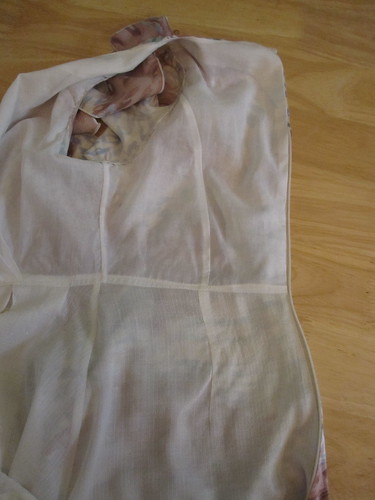
The dress is drafted with a facing, but I prefer to fully line silk because it makes me sweaty. I lined the bodice with cotton batiste, and the skirt with a flowy rayon. For the front skirt, I overlapped the left and right skirt pieces, making the skirt as wide as possible, and cut it in one piece rather than seaming. I considered trying to draft a regular darted lining instead of using the asymmetrically pleated front piece, but decided it would be a lot of trouble for not much reward. The batiste is lightweight enough that it doesn't add any distracting bulk.
I knew the drafted shoulders were going to be too narrow for my taste, and that the neckline would be too wide (further evidence that there is not a real petite sloper). I pulled out my altered bodice pattern for the Burda 08-2009-128 boatneck dress since they have the same neckline. Based on that pattern, I widened the shoulders in toward the neck by 1 1/2". I still get plenty of boat neck effect, but without any bra strap show-through or danger of shoulders falling off.
I thought I would need to lower the front neckline quite a bit for chokiness and flattery--I have a proportionate but short neck and really high necklines aren't the best for that. However, I only needed to lower the neckline by 1/2" to get it to a nice spot.

To up the vintage vibe, I used the drapey sleeves from the Burda 03-2008-116 Duchess of Windsor dress (previously made in knit). Rather than sew the shoulder seam of the sleeve (the sleeves are cut in two pieces), I finished the edge with a serger rolled hem for a split sleeve. To stitch it in place, I put the edges flush together when putting in the ease stitching. It worked like a charm!
I had trouble keeping the sleeve seam allowance pressed toward the bodice, so I hand stitched the seam allowance to the lining.

For further vintage-ness, I shamelessly ripped off Kristy at Lower Your Presser Foot and put in a keyhole neckline above the center back zip (I should mention that as drafted the dress has no CB seam and a side zip). I just sort of sketched the opening onto the interfacing using a Frixion pen, mirrored it on the other side, and followed the line when stitching the lining to the dress.
I used a rouleau loop for the button, tacking it into place on the fashion fabric before adding the lining.
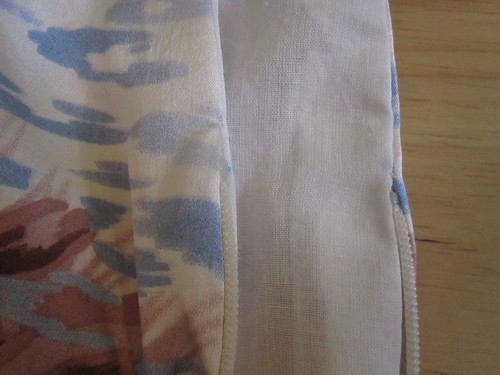
To get a neat finish at the zipper, I marked the position of the upper zipper stop on my lining and stitched my keyhole, keeping the upper edge of the zipper to the right of the presser foot when I got there. Just above the zipper stop, I put down the needle, pivoted, and stitched two stitches over to put the zipper teeth to the left of the presser foot. Then I stitched down the zipper tape as usual to enclose the zip in the lining.

I used one of the buttons I inherited from my grandmother's sewing room as the closure. I don't know if the photo is clear enough to tell, but the brown dots are actually tiny flowers. I know these are meant to be buttons for children's clothes, but I look for every opportunity to use these special buttons. I sew so little brown that I didn't think I'd ever use these.

One thing I often forget to do, but thank goodness remembered this time, was to add some interfacing to the lining at the neckline and down through the keyhole opening.
On the fashion fabric, I interfaced the zipper area. I also interfaced the waistline of the bodice, as it would be supporting a fair amount of weight from the skirt. So as not to interfere with the drape of the waist pleats, I broke the interfacing line there.
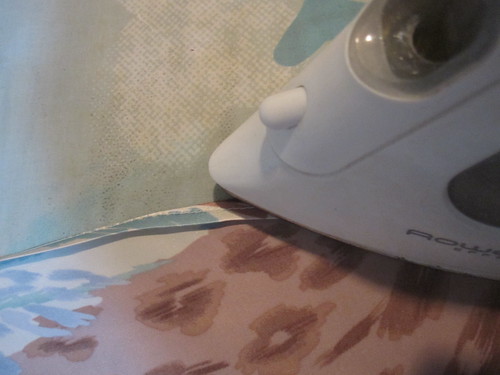
I shortened the hem nearly two inches before cutting. I probably should have only taken off one inch, as I think this could have worked at a slightly longer length. However, I like the length it turned out so that's fine. I did a fairly terrible job on the hem, doing a toddler (or even teenager)-sized baby hem where you stitch the raw edge under and the turn it under again. For the lining, I serged the lower edge, then used the serging as a marker for turning under twice. The lining hem is much nicer than the dress hem. *rollseyes*
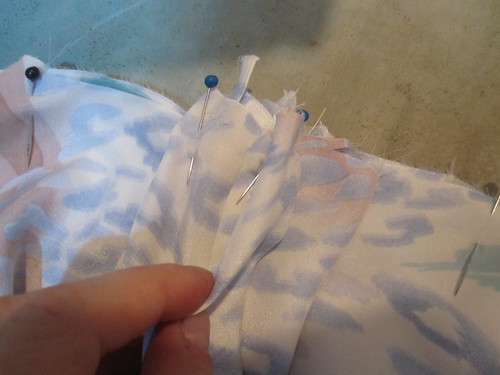
My "special feature" on this dress is a loop hidden in the skirt pleat to hold my work badge. I didn't want to put pockets into the side seams due to (1) laziness, and (2) I didn't want to add weight to the side seams that would interrupt the flow of the dress in motion. Mostly (1) though.
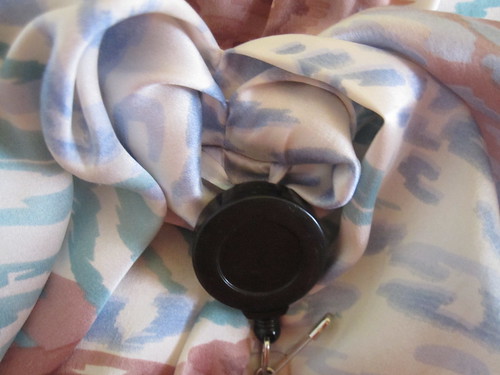
For dresses without pockets, I put a safety pin into the waist seam of dresses to hang my badge on. For silk, I didn't want to be poking a safety pin into it all the time. I've been intending to add a small hanging loop to dresses for a while, and with the inverted pleats in this one it was the perfect opportunity.
The skirt has essentially a really big inverted pleat that you layer into two inverted pleats. I put the hanging loop inside the innermost inverted pleat.
When I finally had some time to sew a couple weekends ago, I couldn't concentrate on one thing for longer than a few minutes. I wanted to do all the projects at once and was paralyzed (I ended up making a bias half slip, a hat, and some pot holders). For this weekend, I realized that PR was having its Natural Fibers Contest, which gave me the impetus to focus on one project. I am happy my brain calmed down enough to concentrate on one thing for more than 12 seconds!

I like this dress. I'm not 100% sold on my print placement. I didn't want to have a wing motif anything like centered on the bodice front, as it would look like a strange superhero costume. But I didn't think about it being right at the neckline; it looks a little like a bib. Hopefully I will unsee that at some point.
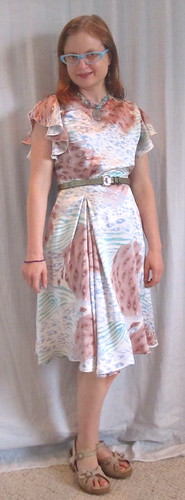
At any rate, it's fun to dress up. You can embrace the vintage and go all out, but it can be styled more modern as well. It's one of those pieces I'll keep in the closet long after the current Gatsby trend ends in case a vaguely 20s look is ever needed.
I think this pattern would work equally well in a more casual cotton, and of course you could easily put a different skirt on the bodice to change up the look.
All photos are here and the pattern review is here.



Comments
Post a Comment